Excerpts from Jim Conrad's
Naturalist Newsletter
from the May 23, 2015 Newsletter issued from Río Lagartos, on the Yucatan Peninsula's northern coast (~N21.60°, ~W88.16°), Yucatán state, MÉXICO
THE BIG SEA-CUCUMBER PEPINEADA
On and off for the last three weeks a certain carnival atmosphere has reigned in Río Lagartos because of sea cucumber fishing season. People here don't care much for sea cucumbers as food, but in Asia they eat them and -- the kiss of death, as with rhinos, elephants and wild ginseng -- regard them as medicinal, even aphrodisiacal. The sea cucumber business is big. Their harvest is regulated, with this year's quota for the Yucatan being 600 metric tons (661 US short tons). Many are taken illegally, despite the Mexican government's efforts at regulation. The species appearing in the pictures look like what's called the Donkey Dung Sea Cucumber, HOLOTHURIA MEXICANA.
My sympathies are with the sea cucumber. However, during these weeks I've witnessed features of the sea cucumber harvest that are worth documenting, if only because it's a traditional event destined to disappear in step with the disappearance of sea cucumbers.
When I jog along the Malecón each morning at 4AM, already the fishermen are out preparing their equipment and heading out to sea. Fishing grounds close to land already have been depleted of sea cucumber so now for a good catch they must go much farther out, into deeper, more dangerous water, so an early start is a good idea.
Normally each boat carries a crew of three. One person works on the sea floor breathing air through a hose attached to a special kind of mask coming from a small air compressor on the boat. He puts sea cucumbers into a bag, gives the bag's line a jerk, and the second man on top pulls it up. This second man also makes a slit on the bottom surface of each sea cucumber, guts it, and tosses the intestines overboard. The third man is at the boat motor, keeping the boat in place above the man on the bottom.
In mid afternoon, boats begin streaming back home through the canal in front of Río Lagartos. This Friday I was returning from a flamingo tour when I snapped a small part of the inflow, which continued for another couple of hours, shown below:
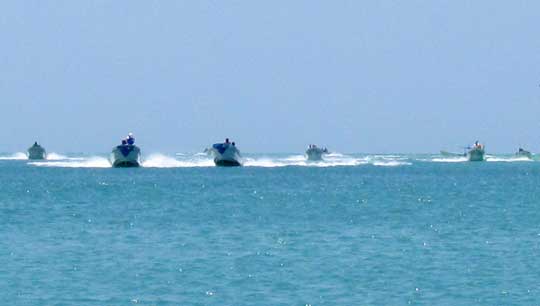
With big ice-coolers full of sea cucumbers, the boats head for their home fishing cooperative storage facility dock, where they line up side-by-side, waiting their turn to have their day's catch taken off and weighed, as shown below:
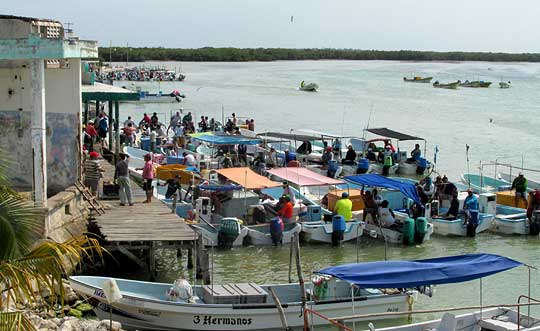
Each sea cucumber is quickly examined to assure that it's been properly gutted. Those that haven't been go into one container, while those properly cleaned are put into another. Below, you can see a container being weighed:
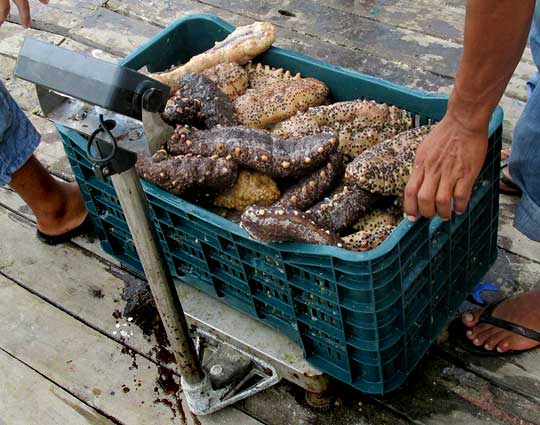
The sea cucumbers then are dumped into large vats and boiled. Boiling softens them, facilitating the drying-out process. Below, you can see vats of boiling sea cucumbers:
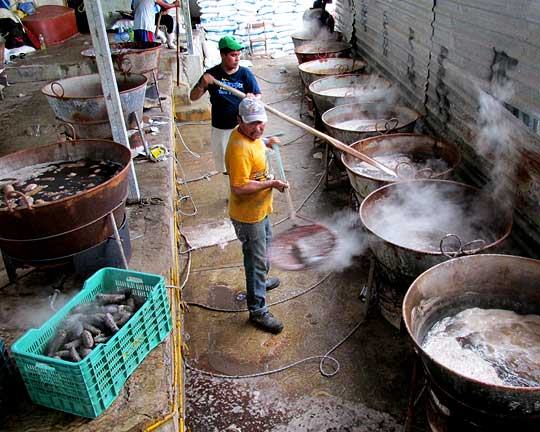
Desiccation begins by packing layers of sea cucumbers with alternating layers of salt. In the above photo, white bags of salt are stacked against the wall in the background. After a day of drying in salt, the sea cucumbers are removed, boiled again, then repacked in salt again. Later they're dried more in the sun, as shown below:
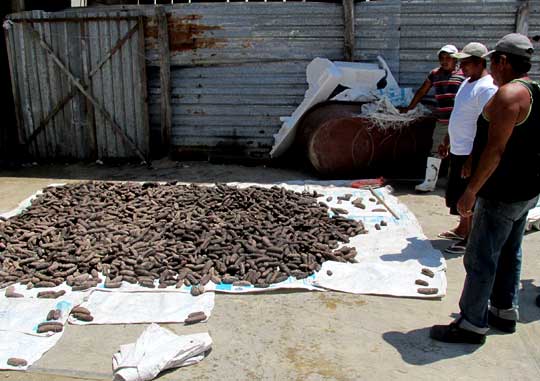
In that picture the sea cucumbers already have shrunk dramatically in size. A fishermen leaning against a wall one afternoon outside the restaurant where I teach English told me that fully dried sea cucumbers are only about 1½ inches long (6cm). It takes 40-42 completely dried sea cucumbers to make a kilogram (15 per pound). In this dried-out state they're shipped to Asia, where they're re-hydrated, usually by microwaving them several times in water.
It's hard to believe the drama accompanying the pepineada. During the first week, about half the days were too windy to go out fishing, so fishermen hang around the second week hoping for permission to go out and make up their lost days. The permission was late in coming. One day the fishermen -- many from other towns, hugely swelling Río Lagartos's population -- decided to go out no matter what the government said. As I jogged at 4AM that morning, I heard a truck with a loudspeaker on it passing down the streets announcing that no permission was granted for that day, and that anyone who went out fishing would be treated as a pirate. Few if any fishermen went out that day. Big trucks loaded with ice sat with their cargoes melting, day after day.
This week, permission was granted and enormous numbers of sea cucumber were taken.
During these three weeks there's been robbery of sea cucumber catches, burnings of boats by fishermen jealous of their sea cucumber fishing grounds, deaths of fishermen suffering the bends as they came up from the ocean floor too fast, and all kinds of rumors. One day it seemed that most of Río Lagartos's population was gathered around a large, run-down tug newly towed up to a pier along the Malecón. People said the Navy had had a gun battle with "narco-sea-cucumber pirates" and confiscated their boat. The next day I heard that the body of one of the pirates had washed into the mangroves across from Río Lagartos. However, I can confirm none of this, though other details of the tension and violence along the coast are well documented in regional news outlets. All I know for sure is that for days the tug has been here guarded by men in uniforms, carrying automatic weapons.